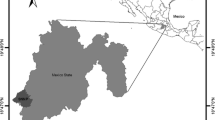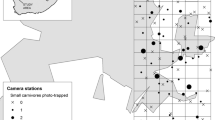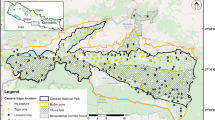Abstract
Previous studies carried out in the Doñana National Park reported that red foxes (Vulpes vulpes) were killed by Iberian lynxes (Lynx pardinus), whereas similar-sized Eurasian badgers (Meles meles) were not. Therefore, we predicted that fox would avoid lynx predation risk by niche segregation whereas we did not expect such a segregation between badger and lynx. As an approach for evaluating our predictions, we compared their diet, activity patterns, and habitat use in an area of Doñana where the three carnivores are sympatric. Lynxes preyed almost uniquely on European rabbits (Oryctolagus cuniculus), and though badgers and foxes were omnivorous, rabbits also were a major prey, resulting in high overlaps throughout the year. However, badgers preyed largely on small rabbits, whereas lynxes and foxes preyed mainly on medium-sized rabbits. There were also interspecific differences in activity patterns. Maximum levels of activity among lynxes were during sunrise and dusk (49–67%). Foxes were most active during dusk and night (34–67%), and badgers were mainly nocturnal (53–87%). Though there were seasonal differences in the amount of activity of each species, specific activity patterns changed little throughout the year. There was a strong difference in annual habitat use by the three species (P < 0.0001). Lynxes used mainly the Mediterranean scrubland during both the active (PMAX) and the resting (PMIN) periods. During PMIN, foxes used the Mediterranean scrubland intensively (40% of locations on average), but during PMAX, they used the pastureland much more intensively despite this habitat being poorer in their main prey (rabbits). As a consequence, foxes and lynxes exhibited segregation in their habitat use during the active period. Badgers also used the Mediterranean scrubland intensively, especially during PMIN. There were no seasonal differences in habitat use for lynx and fox, but there was for badgers (P < 0.015). Within the study area, the three species selected habitat suggesting they were sensitive to factors such as vegetation and prey abundance. However, in general, carnivore habitat use did not correlate with rabbit abundance. We propose that foxes avoided lynxes by using, during activity, habitats not frequented by lynxes, and that a low predation risk associated with the distinctive foraging mode of badgers may facilitate its coexistence with other carnivores.
Similar content being viewed by others
Author information
Authors and Affiliations
Additional information
Received: 17 November 1998 / Accepted: 1 May 1999
Rights and permissions
About this article
Cite this article
Fedriani, J., Palomares, F. & Delibes, M. Niche relations among three sympatric Mediterranean carnivores. Oecologia 121, 138–148 (1999). https://doi.org/10.1007/s004420050915
Issue Date:
DOI: https://doi.org/10.1007/s004420050915




